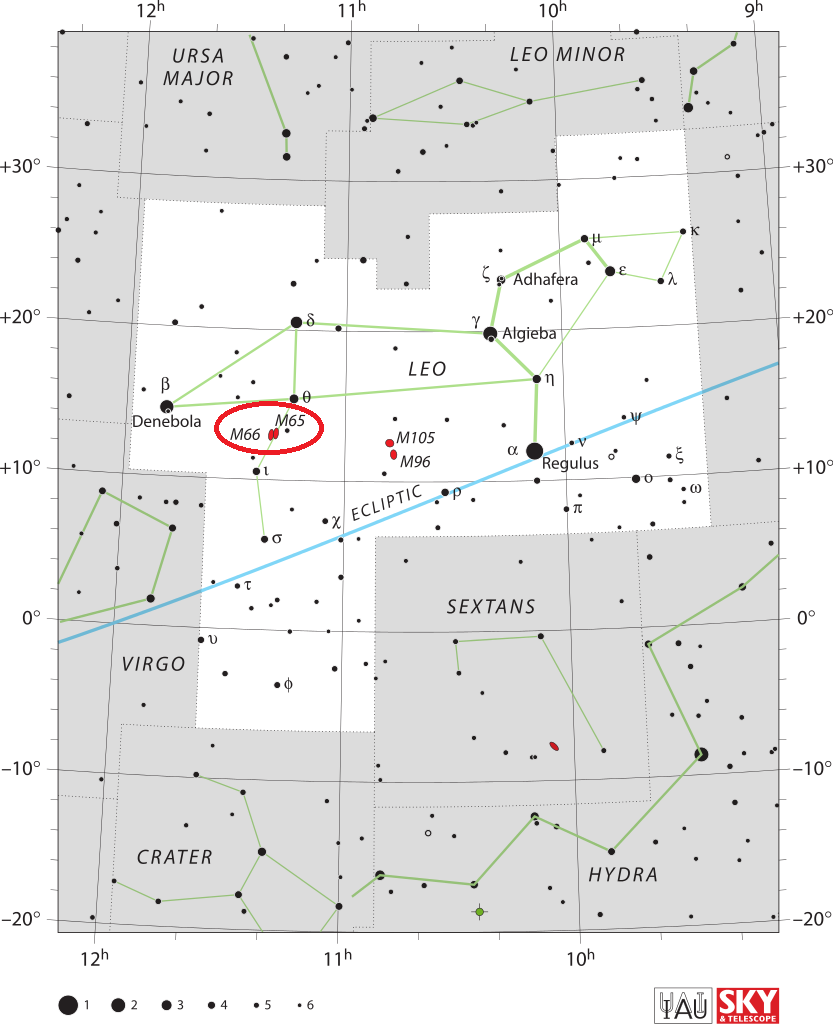Messier 66 (M66), the brightest and largest member of the Leo Triplet of galaxies, is an intermediate spiral galaxy located in Leo constellation. The galaxy lies at a distance of about 36 million light years from Earth and has an apparent magnitude of 8.9. It has the designation NGC 3627 in the New General Catalogue.
Messier 66 occupies an area of 9.1 by 4.2 arc minutes of apparent sky, which corresponds to a spatial diameter of about 95,000 light years. It can be seen in the same field of view as its neighbours M65 and NGC 3628. M66 is separated from M65 by only 200,000 light years, or 20 arc minutes of apparent sky.
The Leo Triplet can be found between the stars Theta and Iota Leonis, or along the line from the bright star Denebola to Regulus, the brightest star in Leo.
M66 is the easternmost of the two Messier galaxies in the group. It lies only 0.33 degrees to the southeast of M65, which is located about 3 degrees to the south-southeast of Theta Leonis.
Messier 66 and Messier 65 are visible even in small binoculars, which reveal two fuzzy patches of light, Small telescopes will show the galaxies’ oval shapes and brighter centres. Medium-sized telescopes will reveal the bright cores more clearly, while 10-inch and larger telescopes will show hints of the spiral arms. The best time of year to observe M66 is during the months of March, April and May.
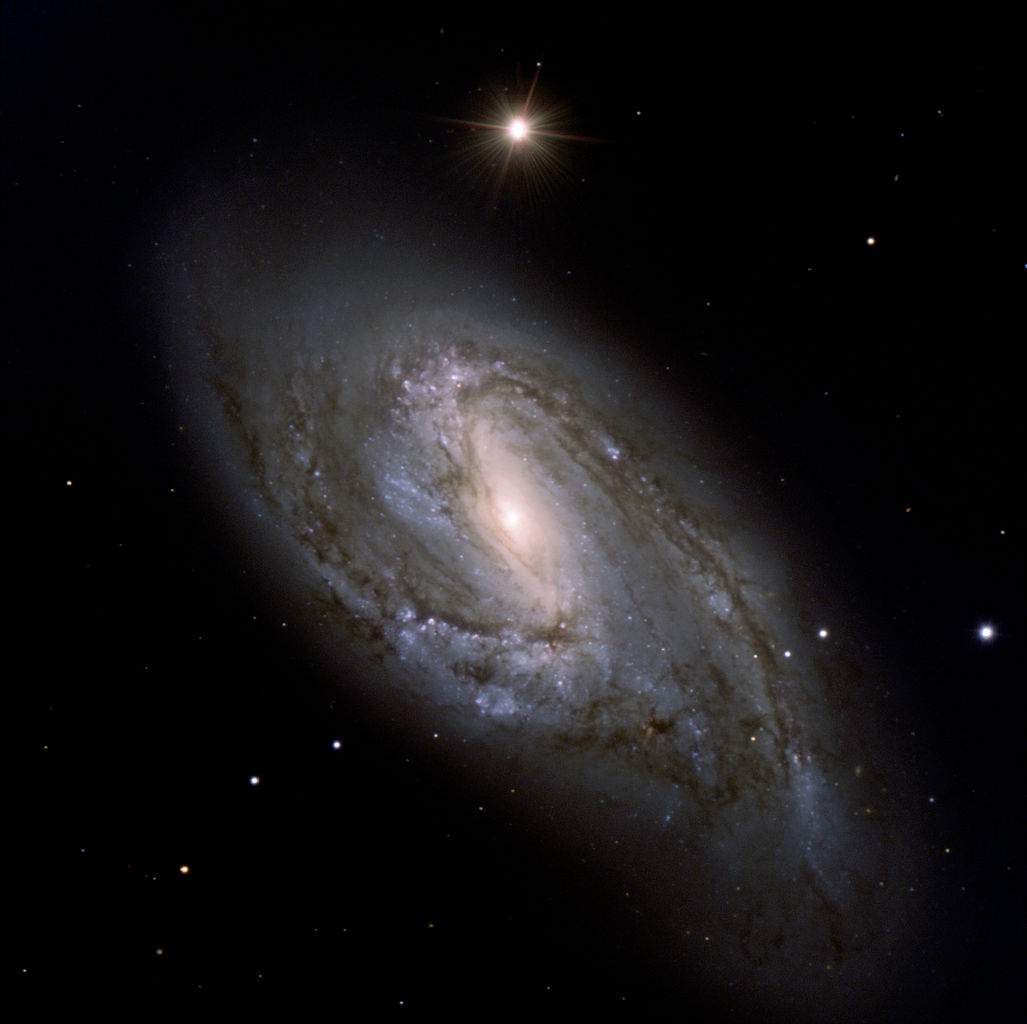
Messier 66 is the most prominent member of the Leo Triplet, also known as the M66 Group, which consists of M66, M65, NGC 3628 and possibly two other galaxies. M66 is notable for its outstanding dark dust lanes and bright starburst regions along the spiral arms. The galaxy is receding from us at 727 km/s.
Gravitational interaction with the nearby galaxies Messier 65 and NGC 3628 has significantly affected M66. The galaxy’s past encounter with NGC 3628 has resulted in an extremely high central mass concentration, asymmetrical spiral arms and a clump of H I material – an interstellar cloud composed of neutral atomic hydrogen (H I) – removed from one of the galaxy’s spiral arms. As a result, the galaxy appears to have a conspicuous and unusual structure of spiral arms and dust lanes. The distorted, hooked spiral arms appear displaced above the plane of the galaxy’s disk. For this reason, Halton Arp included M66 in his Atlas of Peculiar Galaxies as Arp 16.
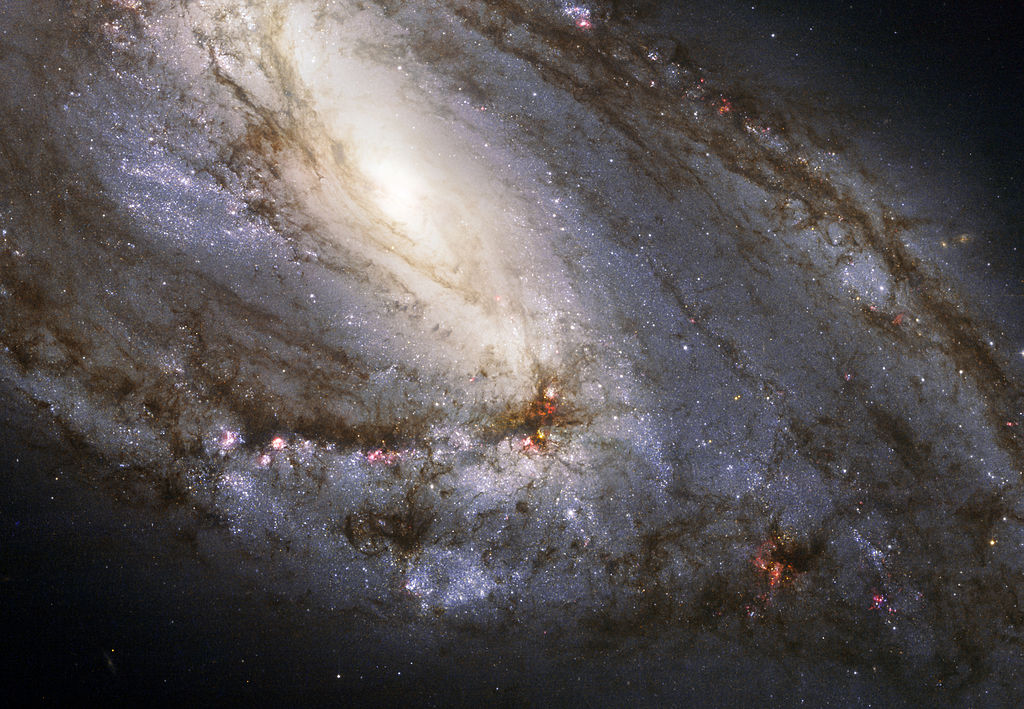
The unusual spiral galaxy, Messier 66, is located at a distance of about 35 million light-years in the constellation of Leo. Together with Messier 65 and NGC 3628, Messier 66 is the member of the Leo Triplet, a trio of interacting spiral galaxies, part of the larger Messier 66 group. Messier 66 wins in size over its fellow triplets — it is about 100 000 light-years across.
This is a composite of images obtained through the following filters: 814W (near infrared), 555W (green) and H-alpha (showing the glowing of the hydrogen gas). They have been combined so to represent the real colors of the galaxy. Image: NASA, ESA and the Hubble Heritage (STScI/AURA)-ESA/Hubble Collaboration
The encounter with NGC 3628, which occurred roughly a billion years ago, affected both galaxies, displacing M66’s bulge slightly from the centre and ripping out a 300,000 light-year tidal stream of stars from NGC 3628.
Four supernovae have been detected in M66 so far: SN 1973R in 1973, SN 1989B in 1989, SN 1997bs in 1997, and SN 2009hd in 2009. The brightest of these, SN 1989B, first spotted on January 31, 1989, reached magnitude 12.2 on February 1, 1989. SN 1973R, a Type II supernova, reached magnitude 15 on December 12, 1973. SN 1997bs was detected on April 15, 1997 about 13 arc seconds west and 67 arc seconds south of the galaxy’s centre. It reached magnitude 17 and was classified as Type IIn. SN 2009hd was discovered at magnitude 15.8, 28 arc seconds east and 42 arc seconds south of the core of M66 on July 2, 2009.
X-ray observations of the galaxy have revealed a number of black hole candidates, including a supermassive black hole candidate at the galaxy’s core.
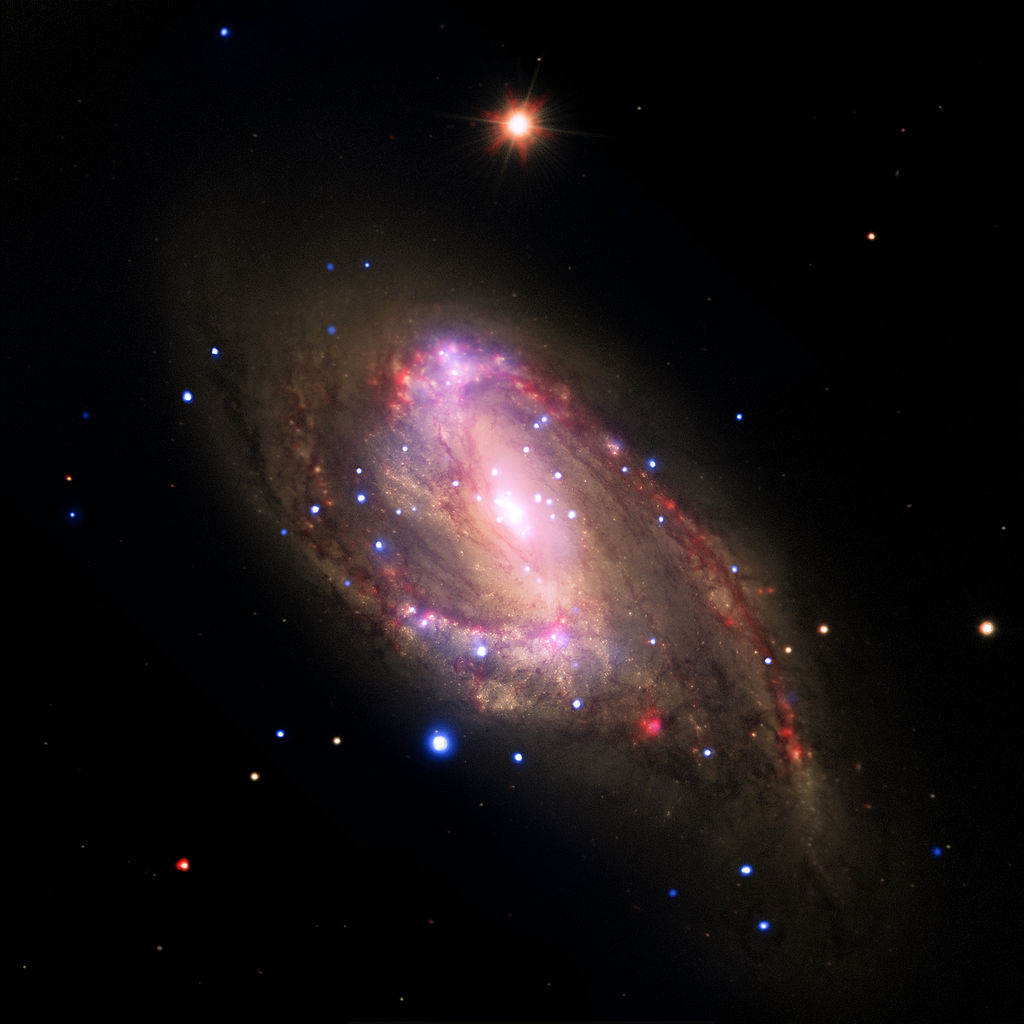
The combined X-ray and infrared data suggest that the nuclear activity in a galaxy is not necessarily related to the amount of star-formation in the galaxy, contrary to some early claims. In contrast, these new results suggest that the mass of the supermassive black hole and the rate at which the black hole accretes matter are both greater for galaxies with greater total masses. Image: NASA/CXC/Ohio State Univ./C.Grier et al.; Optical: NASA/STScI, ESO/WFI; Infrared: NASA/JPL-Caltech
Messier 66 is one of Charles Messier’s original discoveries. The comet hunter found it together with its neighbour M65 on March 1, 1780 and added both objects to his catalogue. The third member of the M66 Group, NGC 3628, was not discovered until April 8, 1784, when William Herschel found it with his telescope, which was considerably larger than the one Messier used.
Messier described M66 as a “nebula discovered in Leo,” adding that “its light is very faint & it is very close to the preceding [Messier 65]: They both appear in the same field in the refractor. The comet of 1773 & 1774 has passed between these two nebulae on November 1 to 2, 1773. M. Messier didn’t see them at that time, no doubt, because of the light of the comet.”
William Herschel observed M66 in April 1784 and described it as a bright, much extended “nebula of irregular figure,” adding that “the extension is chiefly in the direction of the meridian and the greatest brightness near the middle.”
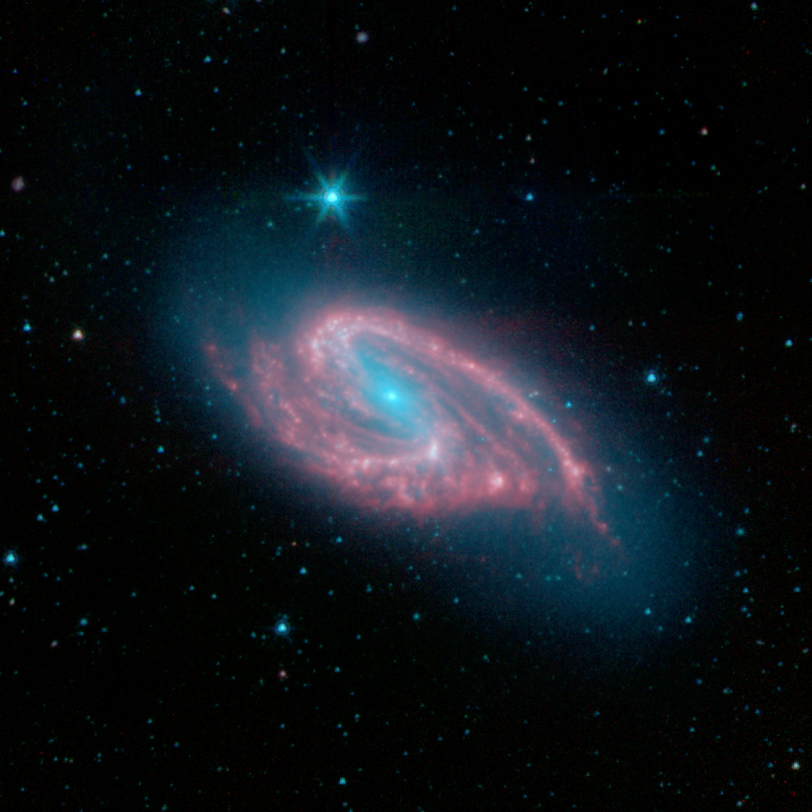
John Herschel catalogued the object as h 857 and later added it to the General Catalogue as GC 2377. He noted, “Bright; very large; much extended in position angle 150 degrees; much brighter toward the middle; 2 stars north preceding [NW].”
Admiral William Henry Smyth wrongly attributed the discovery of M65 and M66 to Messier’s colleague Pierre Méchain and a number of sources adopted the error, even though Messier had not acknowledged Méchain’s sighting, which he had always done.
Smyth offered the following description of M66:
A large elongated nebula, with a bright nucleus, on the Lion‘s haunch, trending np [north preceding, NW] and sf [south following, SE]; this beautiful specimen of perspective lies just 3deg south-east of Theta Leonis. It is preceded at about 73s by another of a similar shape, which is Messier’s No. 65, and both are in the field at the same time, under a moderate power, together with several stars. They were pointed out by Méchain to Messier in 1780, and they appeared faint and hazy to him. The above is their appearance in my instrument.
These inconceivably vast creations are followed, exactly on the same parallel, ar Delta AR=174s, by another elliptical nebula of even a more stupendous character as to apparent dimensions. It was discovered by H. [John Herschel], in sweeping, and is No. 875 in his Catalogue of 1830 [probably an erroneous position for re-observed M66].
The two preceding of these singular objects were examined by Sir William Herschel, and his son [JH] also; and the latter says, “The general form of elongated nebulae is elliptic, and their condensation towards the centre is almost invariably such as would arise from the superposition of luminous elliptic strata, increasing in density towards the centre. In many cases the increase of density is obviously attended with a diminution of ellipticity, or a nearer approach to the globular form in the central than in the exterior strata.” He then supposes the general constitution of those nebulae to be that of oblate spheroidal masses of every degree of flatness from the sphere to the disk, and of every variety in respect of the law of their density, and ellipticity towards the centre. This must appear startling and paradoxical to those who imagine that the forms of these systems are maintained by forces identical with those which determine the form of a fluid mass in rotation; because, if the nebulae be only clusters of discrete stars, as in the greater number of cases there is every reason to believe them to be, no pressure can propagate through them. Consequently, since no general rotation of such a system as one mass can be supposed, Sir John suggests a scheme which he shows is not, under certain conditions, inconsistent with the law of gravitation. “It must rather be conceived,” he tells us,” as a quiescent form, comprising within its limits an indefinite magnitude of individual constituents, which, for aught we can tell, may be moving one among the other, each animated by its own inherent projectile force, and deflected into an orbit more or less complicated, by the influence of that law of internal gravitation which may result from the compounded attractions of all its parts.”
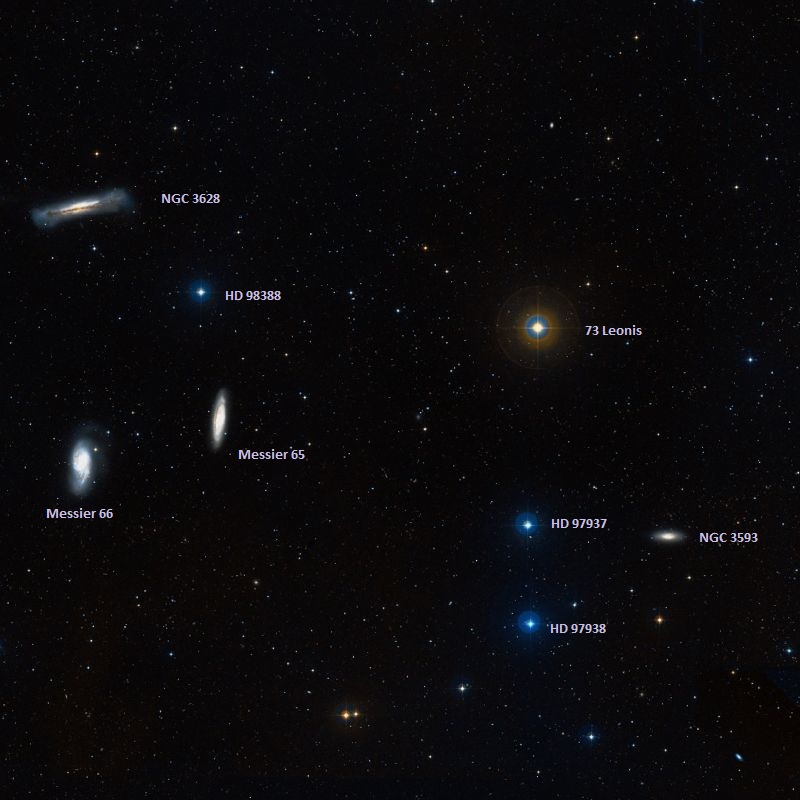
FACTS
| Object: Galaxy |
| Type: Spiral |
| Class: SAB(s)b |
| Designations: Messier 66, M66, NGC 3627, Arp 16, PGC 34695, UGC 6346, Ark 288, IRAS F11176+1315, 2MASX J11201502+1259286, MCG+02-29-019, RGB J1120.3+1259, VV 308a, Z 1117.6+1316 |
| Features: Member of the Leo Triplet |
| Constellation: Leo |
| Right ascension: 11h 20m 15s |
| Declination: +12°59’30” |
| Distance: 36 million light years |
| Number of stars: 200 billion |
| Apparent magnitude: +8.9 |
| Apparent dimensions: 9′.1 x 4′.2 |
| Radius: 47,500 light years |
| Redshift: 0.002425 |
LOCATION
